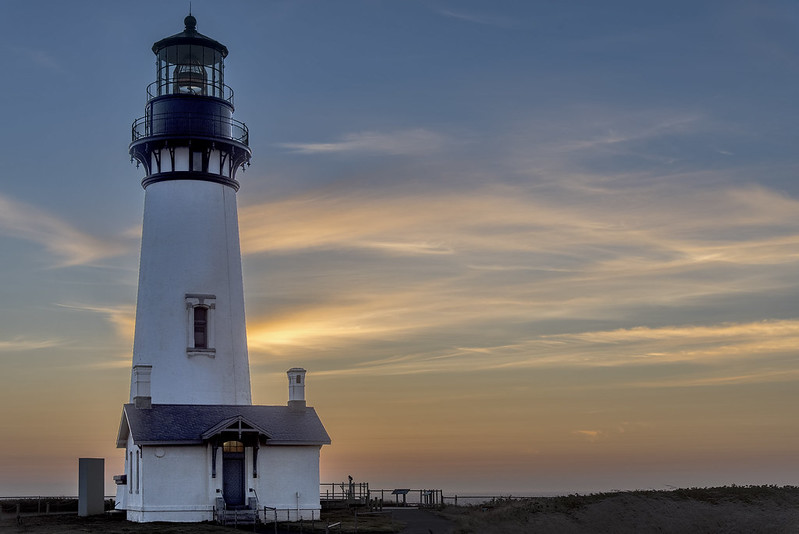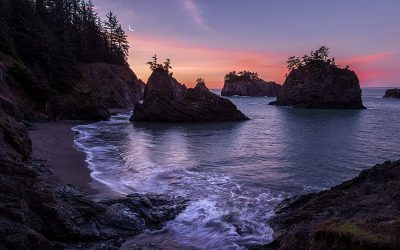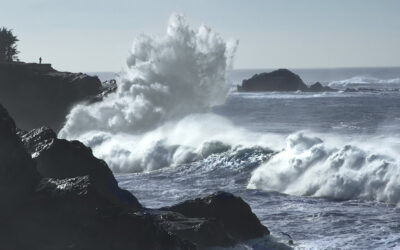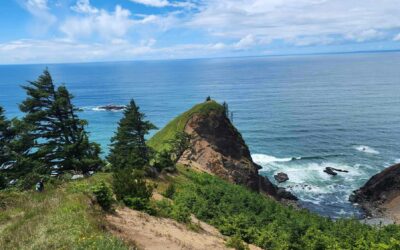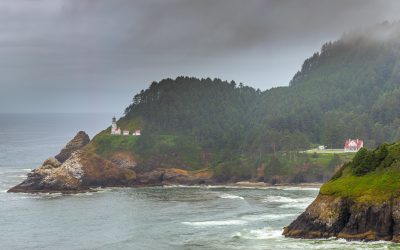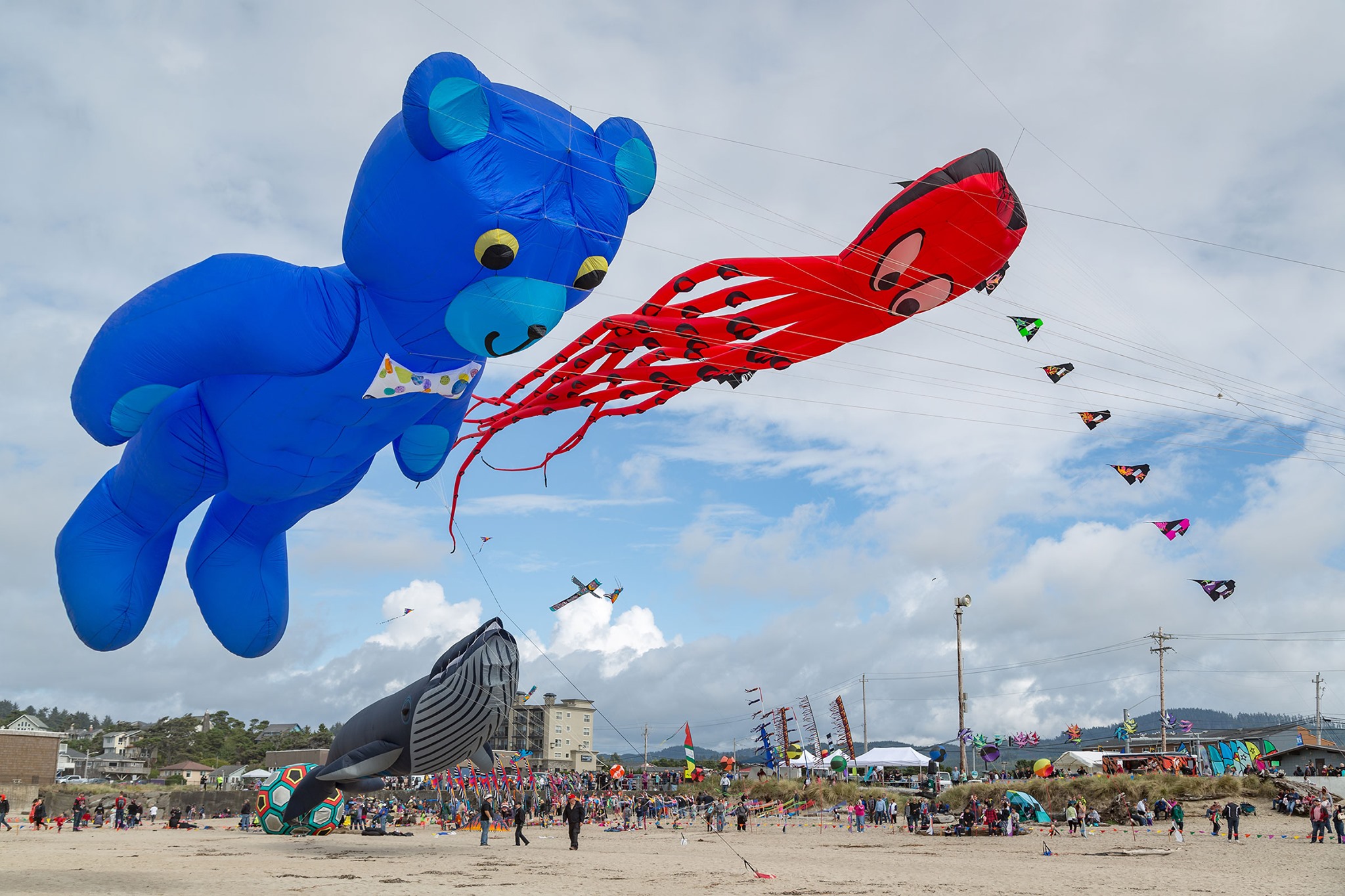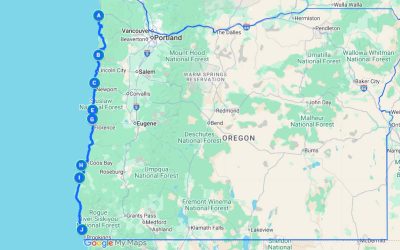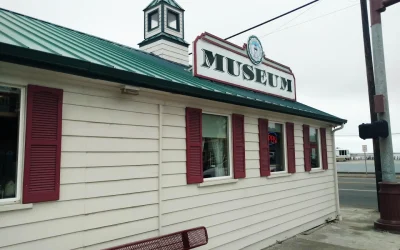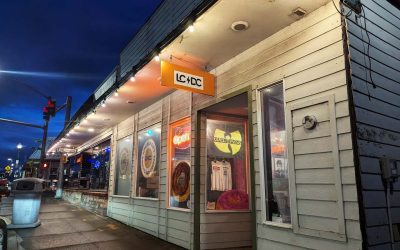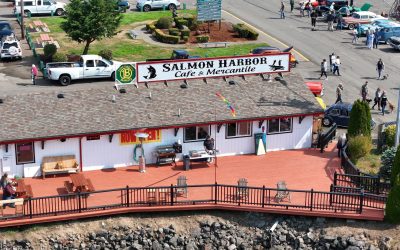Ready for an adventure? Tour some of Oregon's most iconic lighthouses for a unique experience! Discover their history and explore stunning Pacific Ocean views along the way. We already know the Oregon Coast is one of the best places to visit in the Beaver State, and if you're going to visit anytime soon you'll definitely want to check out the incredible lighthouses — in all, there's a total of eleven Oregon coast lighthouses.
Many of these have been restored, and offer a look back into Oregon's past. Two of them, Cleft of the Rock Lighthouse and Pelican Bay Lighthouse, were created by lighthouse enthusiasts.
What lighthouses are on the Oregon coast?
There are several lighthouses located on the Oregon coast, each with its own unique history and architectural features.
Many of these lighthouses are open to the public and offer guided tours during the summer months. Each lighthouse offers its own unique history and architectural features, making them a popular destination for visitors looking to explore the natural beauty and rich history of the Oregon coast. The lighthouses in Oregon are as follows in this article.
Tillamook Rock Lighthouse
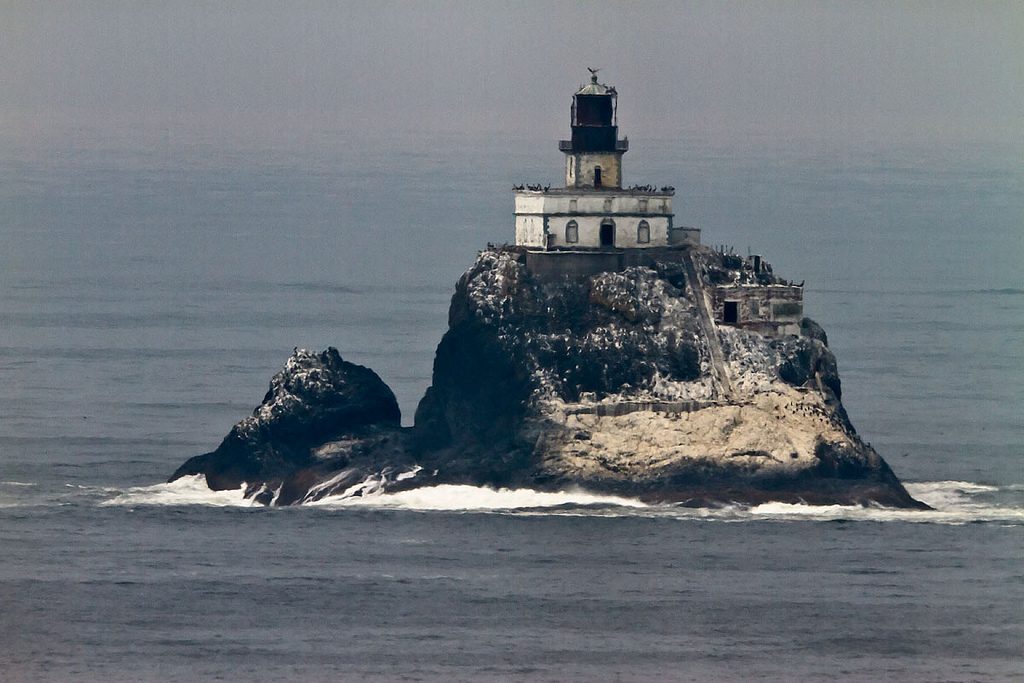
The Tillamook Rock Lighthouse, is also known as "Terrible Tilly," due to erratic weather conditions and the dangerous commute for keepers and suppliers. Listed on the National Register of Historic Places (NRHP) in 1981. Tillamook Rock is not among scenic lighthouses open to the public but is one of the most scenic Oregon lighthouses out there.
Do you love Oregon?
Sign up for monthly emails full of local travel inspiration and fun trip ideas. In each newsletter we'll share upcoming events, new things to do, hot dining spots and great travel ideas.
The construction of the lighthouse began in 1878 and was completed in 1881. The location was chosen because of the high number of shipwrecks that occurred in the area due to the rocks and rough waters. The lighthouse stands at 133 feet tall and was built to withstand the extreme weather conditions, including strong winds and powerful waves. The construction of the lighthouse was no easy feat, as the rugged terrain and remote location made it a challenging project.
The first keepers of the lighthouse were tasked with keeping the light burning 24 hours a day, seven days a week, to ensure that ships could safely navigate the treacherous waters off the Oregon coast. They also had to maintain the lighthouse, keep it clean, and ensure that it was always in good working order.
Throughout the years, the lighthouse faced many challenges. In 1934, a massive storm struck the area, causing significant damage to the lighthouse. The storm caused a 30-foot wave to crash into the lighthouse, damaging the lantern room and destroying the glass panels. The lighthouse keepers were forced to use a makeshift lamp to guide ships until the repairs were completed.
During World War II, the Tillamook Rock Lighthouse was temporarily used as a lookout post to watch for enemy ships. After the war, the lighthouse was automated, and the need for keepers was eliminated. The automation of the lighthouse meant that it no longer required constant maintenance and care from keepers.
In 1957, the lighthouse was decommissioned and replaced by a buoy that could withstand the harsh weather conditions. The lighthouse remained abandoned for many years, and it was vandalized and left to deteriorate.
In the 1980s, the lighthouse was purchased by a private owner who had plans to turn it into a bed and breakfast. The owner spent millions of dollars renovating the lighthouse, but the business venture was unsuccessful due to the lighthouse's remote location and harsh conditions. The lighthouse was eventually sold to the Oregon Parks and Recreation Department, which has maintained the lighthouse and at one point opened it for public tours.
Reported in March of 2022 by OPB, Terrible Tilly was up for sale, listed at $6.5 million by owner Mimi Morisette.
Cape Meares Lighthouse
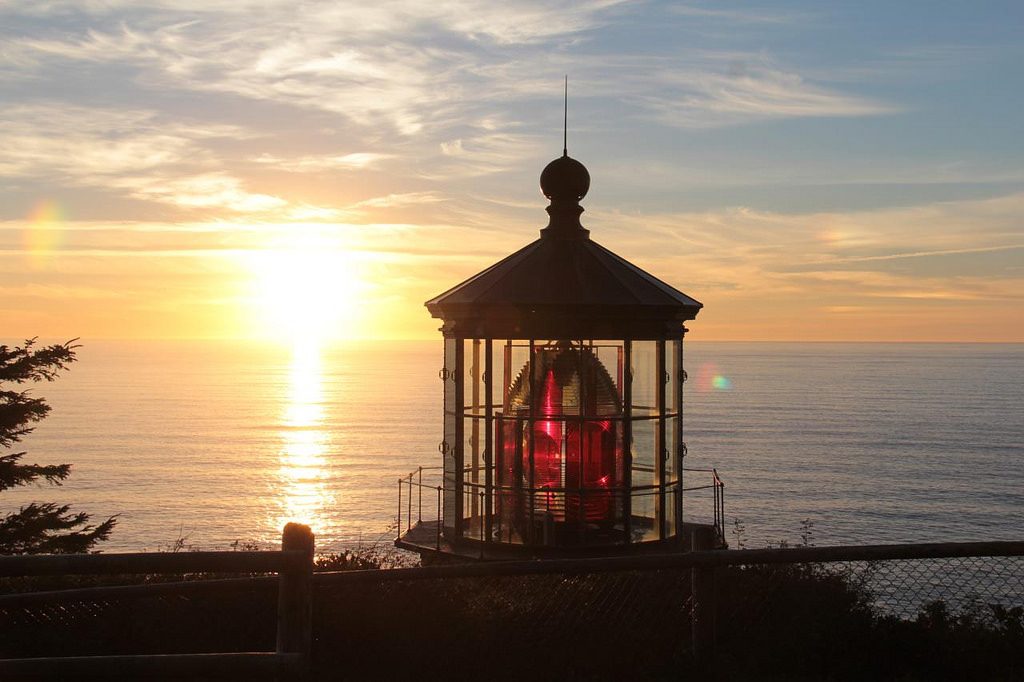
The Cape Meares Lighthouse is a historic lighthouse located on the Oregon coast near the town of Tillamook. Built in 1889, the lighthouse was originally designed to guide ships through the dangerous waters surrounding Tillamook Rock, which had become notorious for shipwrecks.
The lighthouse stands only 38 feet tall and is unique in that it was constructed with bricks rather than the typical stone used for lighthouses of the time. Its octagonal shape is another distinctive feature that sets it apart from other lighthouses in the region.
The Cape Meares Lighthouse remained in operation until 1963, when it was automated. It is now a popular tourist attraction, offering visitors the opportunity to climb to the top of the former lighthouse tower and enjoy panoramic views of the surrounding coastline and the Pacific Ocean.
In addition to its historical significance, the Cape Meares Lighthouse is known for its rich wildlife. Visitors can often spot various species of birds, seals, and even whales from the vantage point of the lighthouse.
The lighthouse is open to the public and offers guided tours during the summer months. The surrounding area also features hiking trails and picnic areas, making it a popular destination for visitors looking to enjoy the natural beauty of the Oregon coast. Whether you are a history buff, a nature lover, or simply looking for a unique experience, a visit to the Cape Meares Lighthouse is well worth the trip.
Directions: Cape Meares is located on the Three Capes Scenic Loop north of the village of Oceanside and approximately 10 miles west of Tillamook. From Highway 101 in Tillamook follow signs to Cape Meares. There is no charge to see the park or the lighthouse.
Yaquina Head Lighthouse
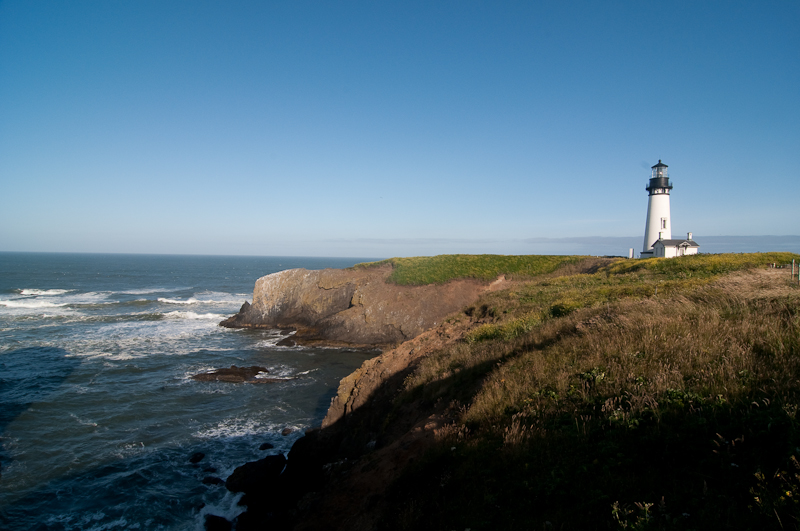
Located on a headland just north of Newport, this lighthouse was listed on NRHP in 1993. Yaquina Head 93 feet high, and is the tallest lighthouse in Oregon and also the 2nd lighthouse built in the Newport area.
You can take a tour here from 12 to 4 p.m. Built in 1872, Yaquina Head Lighthouse stands 93 feet high, making it the tallest lighthouse along the Oregon Coast. Take a guided tour to explore its rich history, ranging from its construction in 1872 to the machinery upgrade that still runs today. Guests can enjoy stunning views of the Pacific Ocean while admiring this majestic feat of architecture.
The construction of the lighthouse was a challenging task due to the rocky terrain and difficult weather conditions in the area. The structure was built using locally quarried stone, and the lantern room was imported from France.
The lighthouse was first lit on August 20, 1873, and its light could be seen for up to 19 miles (30 km) out to sea. The lighthouse played an important role in helping ships navigate the treacherous waters of the Pacific Northwest.
Over the years, the lighthouse underwent various upgrades and renovations to improve its effectiveness. In 1938, the original kerosene lamp was replaced with an electric light, and the lighthouse was automated in 1966.
Today, Yaquina Head Lighthouse is a popular tourist attraction and is open to the public for tours. Visitors can climb to the top of the lighthouse for panoramic views of the surrounding area, including the Pacific Ocean, the coastline, and nearby national wildlife refuge there. The lighthouse is also listed on the National Register of Historic Places and is a designated Oregon State Park.
Directions: Yaquina Head is located about 3 miles north of Newport in the Agate Beach area. Turn at the Yaquina Head Outstanding Natural Area and continue about a mile to the lighthouse.
Yaquina Bay Lighthouse
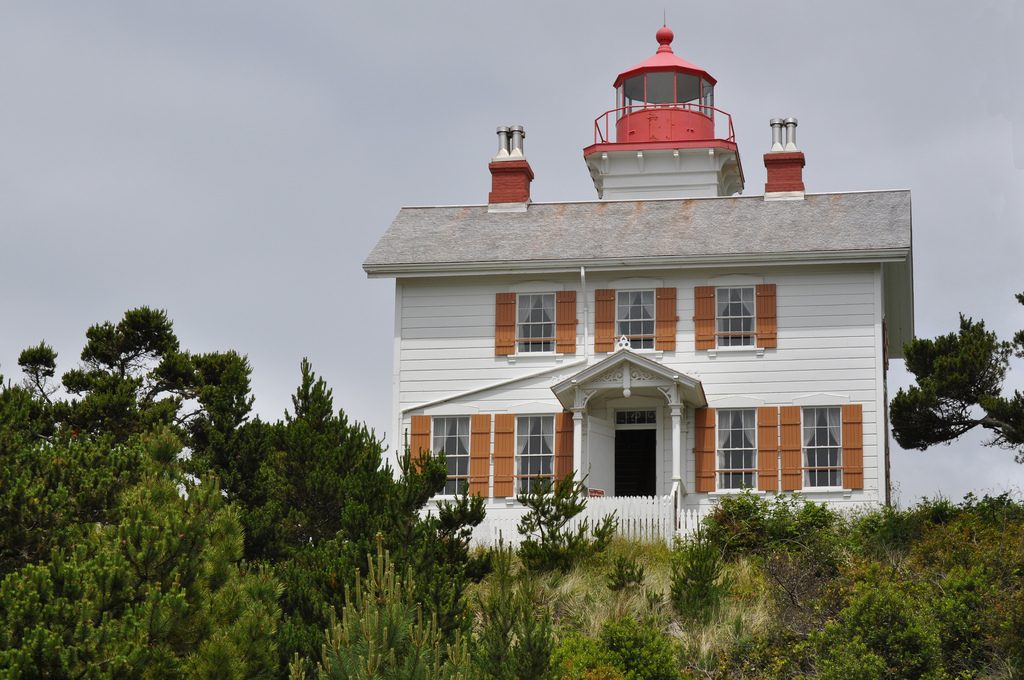
Located at Yaquina Bay State Recreation Site south of Yaquina Head Light, deactivated in 1874 due to the new Yaquina Head Light, added to NRHP in 1970, re-lit in 1996 using a lens provided by lighthouse historian James A. Gibbs.
Directions: Turn right off Highway 101 regardless of which direction you are heading. Yaquina Bay Lighthouse is at the northern end of the bridge just to the west. Follow signs to Yaquina Bay State Recreation Site. There is no fee here, although they do accept donations. Private tours take place outside of normal operating hours and are $20 for one, $10 each for two to four. Call 541-574-3129 to arrange a tour.
Heceta Head Lighthouse
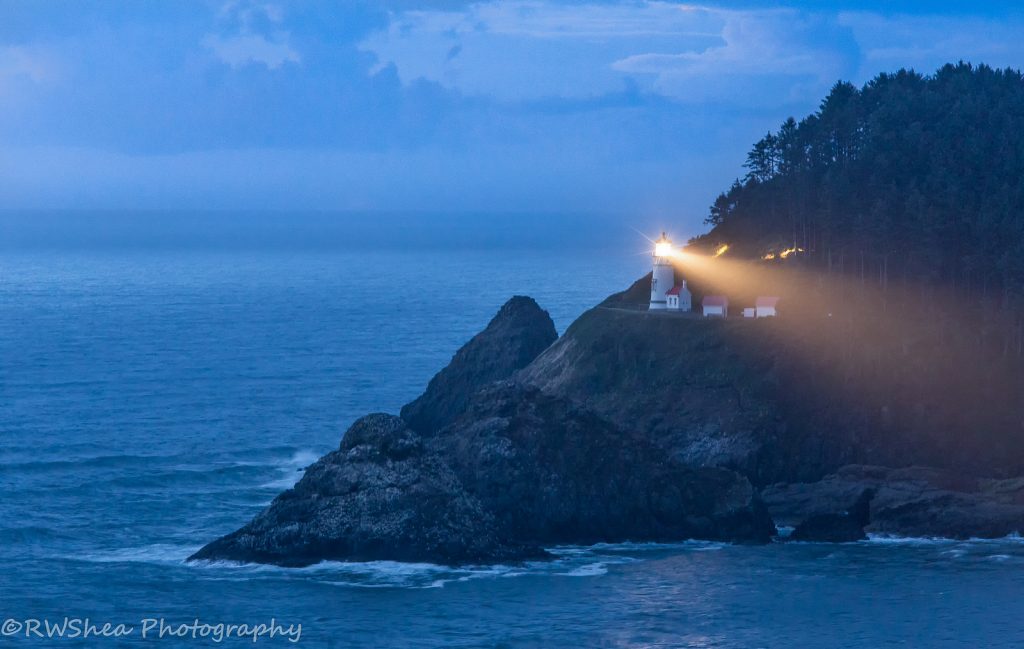
The Heceta Head Light is the brightest light on the Oregon Coast, visible 21 miles (34 km) out to sea, named for Spanish explorer Bruno de Heceta, added to NRHP in 1978, now part of a state park. This Oregon lighthouse is said to be one of the most photographed on the coast. The Heceta Head Lighthouse was first illuminated in 1894, with the light atop the 56-foot tower.
Directions: Off Highway 101 about 12 miles north of Florence. Turn at Heceta Head Lighthouse State Scenic Viewpoint and park at Devil's Elbow Beach, walk up a trail to the lighthouse, and then continue on about a quarter-mile to the lighthouse.
Visitors will not need a day use pass to see the lighthouse, however, a day use pass is required to park in the parking area. Day use passes are not a pass to see the lighthouse. If you are not camping and don't have an annual pass, you will need to purchase a daily parking pass for $5 per vehicle. The pass is good to park an entire day and is good to visit any state park in Oregon.
Pelican Bay Lighthouse
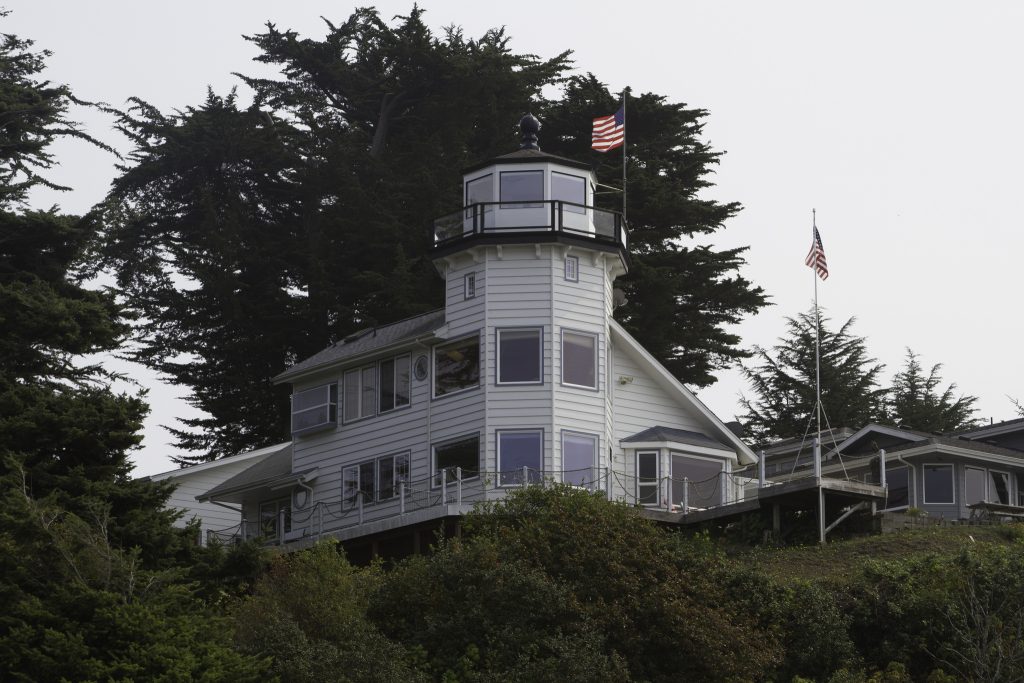
The Pelican Bay Light (or Port of Brookings Light) is a small, privately owned lighthouse in Brookings, Oregon, United States. It overlooks the Port of Brookings Harbor and the mouth of the Chetco River.
The house was built as an addition to an existing home, and Pelican Bay Light is maintained by the Cady family of Brookings, Oregon. First lit in 1999, this lighthouse stands 141 feet above sea level and can be viewed from Brookings Harbor.
Cady family members Bill and JoAnn Cady constructed the Pelican Bay Lighthouse as a private residence. Because this Oregon lighthouse is both a home and a functioning lighthouse, it is not open to the public, but it can be viewed from Highway 101.
Cleft Of The Rock Lighthouse
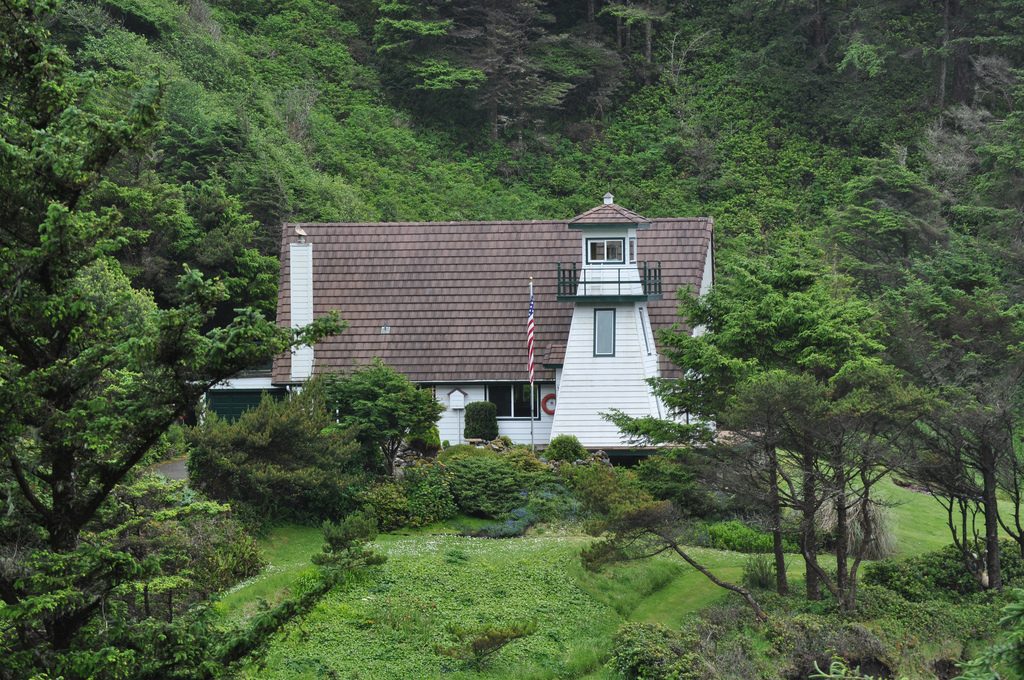
Private aid to navigation, this wooden lighthouse sits about a mile south of Yachats, Oregon. The lighthouse was built by James A. Gibbs in 1976, who is a former U.S. Coast Guardsman, lighthouse keeper, and noted author and historian.
The Cleft Of The Rock Light is not open to the public. Built around 30 years ago, the home's entrance is the rotunda of the lighthouse. The home is filled with photos and historic artifacts of Northwest lighthouses. The original layout was planned as not just a lighthouse but a home as well, and was finished in 1976. Interestingly, it was based on the plans for a Canadian lighthouse, Vancouver Island's Fiddle Reef Light.
Directions: While it is closed to the public, visitors can see the home from Milepost 166 on Highway 101, about a mile and a half south of Yachats.
Related: Yachats, Oregon – “The Gem of the Oregon Coast” Travel Guide
Umpqua River Lighthouse
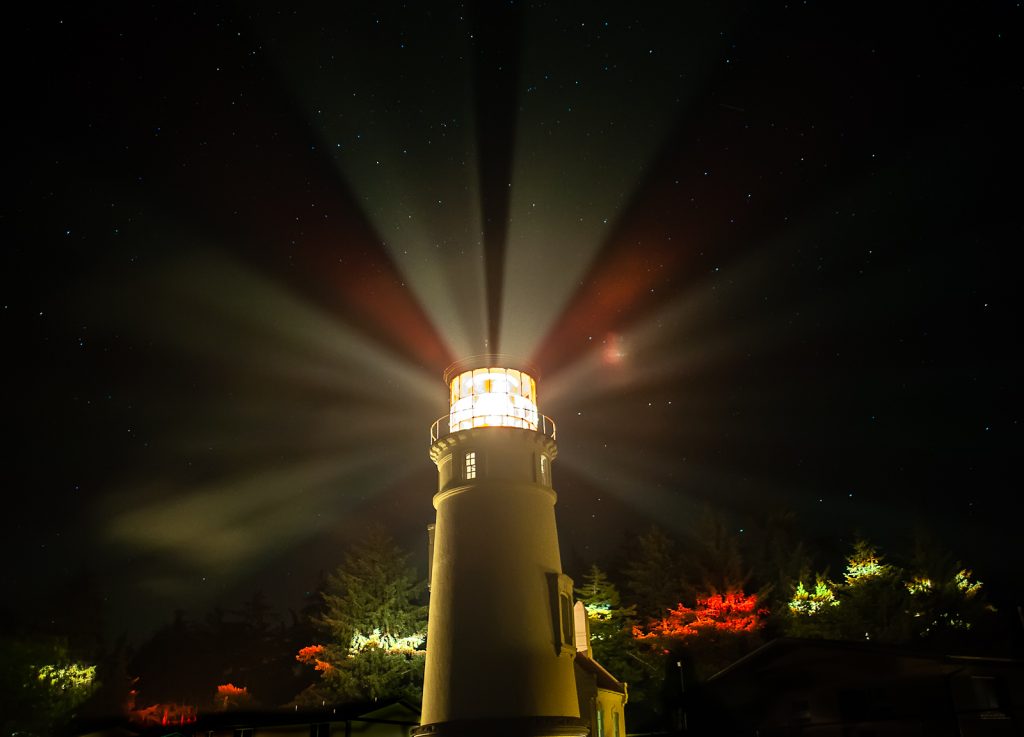
Located at the mouth of Winchester Bay, Oregon, the first Umpqua River Lighthouse near the town of Reedsport, this magnificent lighthouse was built in 1855 and lit in 1857. Built along the river channel, the original light was vulnerable to seasonal flooding.
This led to yearly erosion of the sand embankment of the light. In October 1863, the building's foundations had become too unstable and the structure soon collapsed. Before its collapse, the Light House Board had foreseen the need to build a new light at the location. However, it was 1888 before Congress approved of the construction of a new light.
The Umpqua River Lighthouse stands at 65 feet tall and features a distinctive red and white striped tower. The tower is equipped with a first-order Fresnel lens, which was once powered by a hand-cranked clockwork mechanism. The lighthouse also features a keeper's quarters, which now serves as a museum that showcases the history of the Umpqua River Lighthouse and the surrounding area.
The lighthouse was originally built to aid ships navigating the treacherous Umpqua River bar, which was known for its dangerous currents and shifting sands. Over the years, the lighthouse played a crucial role in ensuring the safe passage of ships through the bar and up the river to the nearby town of Gardiner.
Tours of the lighthouse are given daily year-round. For winter tours, call for an appointment 541-271-4631. Hit the link here for more information on pricing and tours.
Directions: Umpqua River Lighthouse is located on Umpqua Lighthouse Loop out of Winchester Bay. About a mile out of Winchester Bay, watch for signs for when to turn uphill to the lighthouse, state park, and onto Highway 101.
Cape Arago Lighthouse
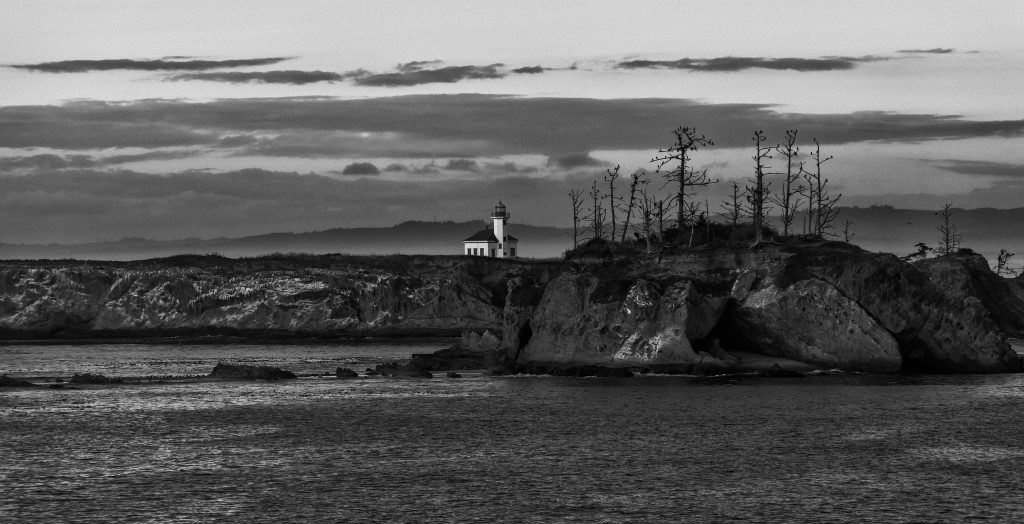
The Cape Arago Light (formerly known as Cape Gregory Light) is a lighthouse located in Charleston, Oregon. It is located 2.6 miles (4.2 km) north of Cape Arago.
Starting in the mid-19th century, Coos Bay had become an important shipping point on the west coast of the United States. The amount of shipping at the time warranted the building of a light at the location, and in 1864, funds were given to build the harbor's light. In 1866, the first light was illuminated. This first tower, which housed a fourth-order Fresnel lens, was nothing more than a 25-foot (7.6 m) octagonal tower with a skeleton base. This tower, located on the west end of an island, was connected to keeper's residence via a 1,300-foot (400 m) wooden walkway. However, because of its location on the island, the light was greatly exposed to the elements along the Pacific and soon was in need of repairs. Over the next 35 years, much of the station's infrastructure had to be repaired or replaced. Several improvements were also made during this time, including the installation of a fog signal and a new boathouse.
Directions: Cape Arago Lighthouse is located about 4 miles south of Charleston between Sunset Bay and Shore Acres state parks. Follow signs to the state parks.
Coquille River Lighthouse
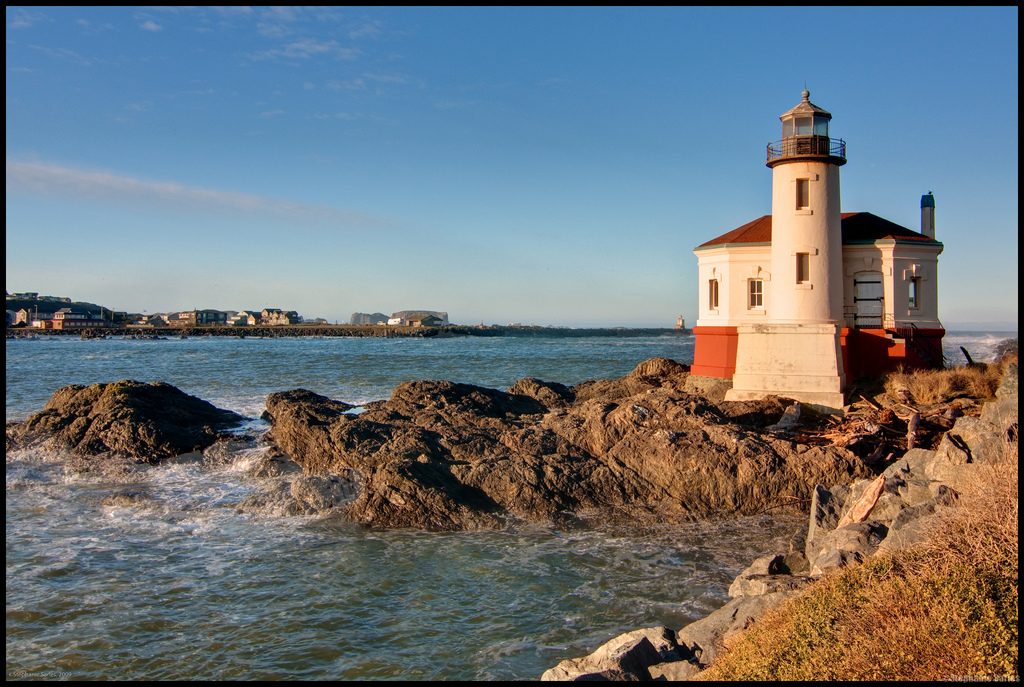
Coquille River Light (formerly known as Bandon Light) is a lighthouse located near Bandon, Oregon. It is currently maintained by the Oregon Parks and Recreation Department as a part of Bullards Beach State Park. Bandon is easily one of the most popular and beautiful places you can visit on the Oregon Coast.
Originally named Bandon Light, Coquille River Light was commissioned in 1895. First lit on February 29, 1896, the light guided mariners past the dangerous shifting sandbars into the Coquille River and harbor at Bandon. The light contained a fourth-order Fresnel lens and was connected to the nearby keeper's house by a wooden walkway. In September 1936, a large wildfire swept through the surrounding area, and destroyed most of Bandon. The town soon became bankrupt as a result of the decline in shipping. Coquille Light was shut down in 1939 and replaced by an automated light on the south jetty.
The signal room is open 11 a.m. to 5 p.m. daily from mid-May through September. It's staffed with volunteers who interpret the history of the area. For safety concerns, the tower is closed to the public. You can call 541-347-2209 for more information on visiting.
Directions: Within Bullards Beach State Park. Turn at the state park sign about 2 miles north of Bandon. Follow signs to the lighthouse.
READ MORE: Add Charming Bandon, Oregon to Your Travel List
Cape Blanco Lighthouse
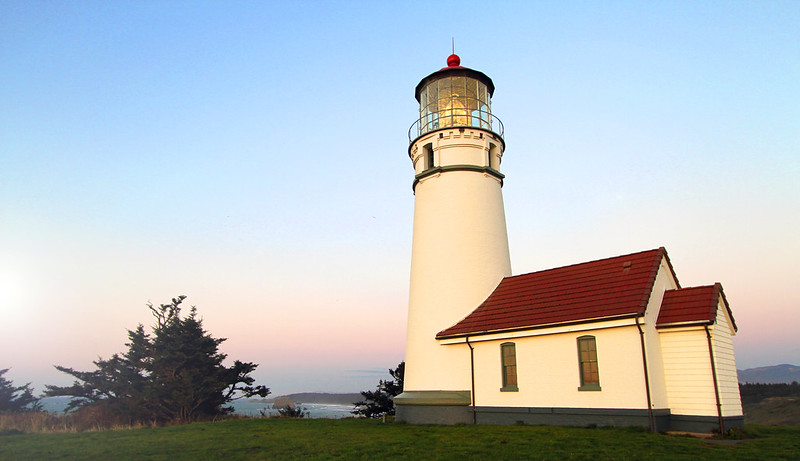
The oldest lighthouse in the Oregon, built in 1870, Cape Blanco Lighthouse sits atop wind-swept bluffs overlooking the Pacific Ocean. These bluffs, the western-most point of land in Oregon, provide an unparalleled opportunity to watch California gray whales and other marine mammals. The site's proximity to the Cape Blanco State Park provides visitors with camping, hiking, and beachcombing opportunities in addition to a lighthouse visit.
The Cape Blanco Lighthouse sits 256 feet above sea level and provides a beautiful beachfront view and whale watching. The lighthouse was built by the British government in 1869 and is currently the oldest lighthouse of its kind in the United States.
Both the lighthouse and house have tours on the same schedule, April through October, Tuesday through Sunday, 10 a.m. to 3:30 p.m. The fee is just $3 per vehicle.
Directions: The turnoff to Cape Blanco State Park is about a mile south of the Sixes River and 4-1/2 miles north of Port Orford. Follow the road a few miles to Hughes House and continue on to the Lighthouse a couple of miles farther.
Are the lighthouses in Oregon open to the public?
Of the 11 Oregon lighthouses on the coast, seven of them are open to the public and most are still active. Two of the lighthouses are privately owned, which are both certified by the U.S. Coast Guard as official private aids to navigation.
Have you visited any of these Oregon lighthouses recently? Which one is your favorite?

